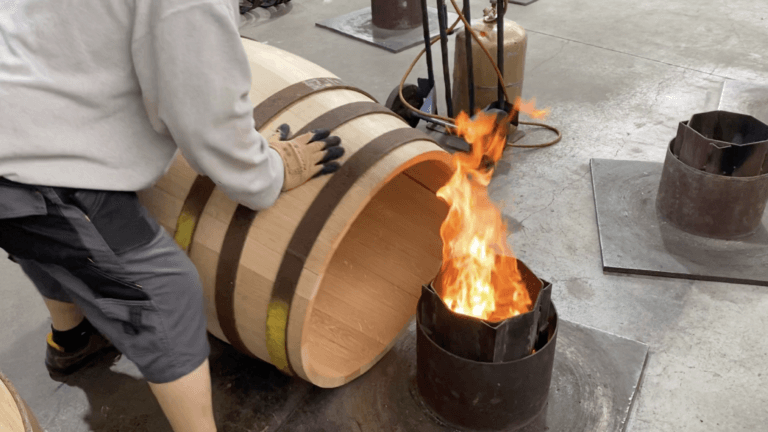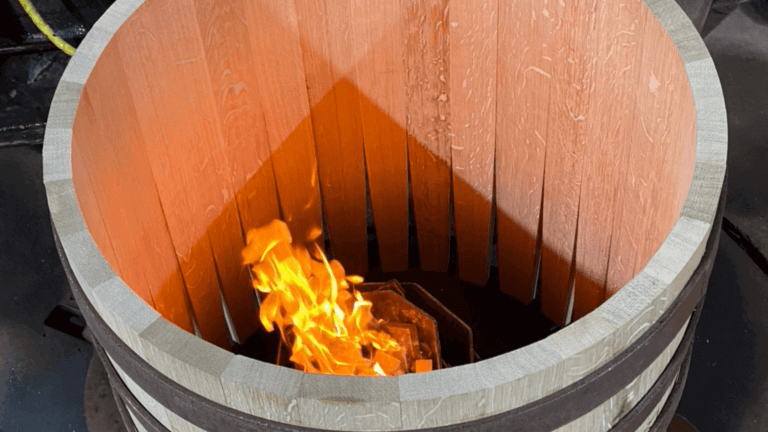
The Cognac appellation
The cognac appellation refers to a long history, international from its origin with distinctive growth areas, to discover with our travel agency
This is where the art of cooperage comes into play. With more than 2000 years of history, from the time of the Gauls through the Middle Ages, coopers pass on the techniques for making barrels, made with only wood and iron, no nails or glue. Only precise and meticulous work will make it possible to make pieces of wood completely watertight and thus obtain a barrel ready to contain an exceptional cognac of the future.
Several types of wood can be used to make a barrel, oak, chestnut, acacia or even ash.
After selecting a tree trunk between 180 and 250 years old, the main trunk is worked by removing the bark and sapwood. In the remaining part, the heart, quarters are split in the direction of the wood grain, the staves. These ultimately represent about 20% of the original tree’s wood volume.
The staves are then dried outdoors for between 2 and 4 years in order to reduce their humidity to 15% and allow the stages of making the cask to be carried out.



When the staves are sufficiently dry, the cooper will select them for the jointing step. The shape of the staves is first modified to make their ends narrower than their central part. The resulting piece of wood is then called a stave.
The cooper then brings together 25 to 30 staves, positioning them side by side in the round with a metal circle. The assembly takes the final shape of a truncated cone. On the side of the circle the assembly takes the final shape of the barrel and, on the other, the staves remain disjointed and form a sort of star. This is the setting in pink.
The carcass thus formed is heated on a heater fed with oak wood offcuts from the different stages of barrel production. During this step, the wood frame is regularly wetted inside and out to make the duels more flexible and prevent them from splitting under the effect of heat. The heat and water will soften the fibers of the wood and allow a cable or jaws to gradually tighten the star-shaped part of the carcass, making the end of the staves touch each other and thus give the barrel its final shape.
As soon as the barrel is bent it is heated a second time on a brazier, this is the bousinage stage, to develop the aromatic palette of the wood.
This heating modifies the chemical bonds of the molecules of the wood and allows this one to develop its aromas which appear according to the temperature of the fire. We obtain aromas of hazelnut, butter, vanilla, even smoke. The heating time is defined with the winemaker, who thus chooses the pairings between wood and wine during the aging of the wine. The different toasts are said to be low, light, medium or intense.
These funds are made by assembling staves, fixed between them by wooden dowels.
The cooper then digs a groove in the end of the staves, called a jable, in which he embeds the bottoms using a lag screw and a hammer used to spread the staves.
A bung hole between 4 and 6 cm in diameter is drilled on the barrel using a twist, then enlarged with a bung hole, its edges are then cauterized using fire.
All the provisional circles are removed, the staves are scraped or sanded and the final circles in steel or galvanized iron blade put in place, a minimum of 3 per side, ie 6 circles.
The tightness of the barrel is checked by pouring in a few liters of water and then putting the barrel under pressure. Internal pressure will push water out if there is a leak.
Once checked, the barrel is sanded and cleaned, one of the bottoms, sometimes both, is laser-pyrographed to mark the name and logo of the cooperage and / or the wine estate.
You just have to come and discover it for yourself and “in person” on site in Charente during a cooperage visit and thus meet a cooper.
Find out more about the coopers of France : https://www.tonneliersdefrance.fr/en/

The cognac appellation refers to a long history, international from its origin with distinctive growth areas, to discover with our travel agency

Let’s push open the doors of a Grande Champagne estate to visit the distillery and meet its master distiller

In the Online Store, choose a packaged stay or buy a gift card to offer. A good way to offer an original destination off the
By subscribing to our newsletter you will receive our news from the Cognac and Charentes vineyards a few times a year.
In accordance with GDPR rules, you can cancel your registration at any time.
| Cookie | Duration | Description |
|---|---|---|
| pll_language | 1 year | The pll _language cookie is used by Polylang to remember the language selected by the user when returning to the website, and also to get the language information when not available in another way. |
| Cookie | Duration | Description |
|---|---|---|
| _gat | 1 minute | This cookie is installed by Google Universal Analytics to restrain request rate and thus limit the collection of data on high traffic sites. |
| Cookie | Duration | Description |
|---|---|---|
| CONSENT | 16 years 3 months 24 days 7 hours | These cookies are set via embedded youtube-videos. They register anonymous statistical data on for example how many times the video is displayed and what settings are used for playback.No sensitive data is collected unless you log in to your google account, in that case your choices are linked with your account, for example if you click “like” on a video. |
| _ga | 2 years | The _ga cookie, installed by Google Analytics, calculates visitor, session and campaign data and also keeps track of site usage for the site's analytics report. The cookie stores information anonymously and assigns a randomly generated number to recognize unique visitors. |
| _gid | 1 day | Installed by Google Analytics, _gid cookie stores information on how visitors use a website, while also creating an analytics report of the website's performance. Some of the data that are collected include the number of visitors, their source, and the pages they visit anonymously. |
| Cookie | Duration | Description |
|---|---|---|
| fr | 3 months | Facebook sets this cookie to show relevant advertisements to users by tracking user behaviour across the web, on sites that have Facebook pixel or Facebook social plugin. |
| IDE | 1 year 24 days | Google DoubleClick IDE cookies are used to store information about how the user uses the website to present them with relevant ads and according to the user profile. |
| test_cookie | 15 minutes | The test_cookie is set by doubleclick.net and is used to determine if the user's browser supports cookies. |
| VISITOR_INFO1_LIVE | 5 months 27 days | A cookie set by YouTube to measure bandwidth that determines whether the user gets the new or old player interface. |
| YSC | session | YSC cookie is set by Youtube and is used to track the views of embedded videos on Youtube pages. |
| yt-remote-connected-devices | never | These cookies are set via embedded youtube-videos. |
| yt-remote-device-id | never | These cookies are set via embedded youtube-videos. |
| yt.innertube::nextId | never | These cookies are set via embedded youtube-videos. |
| yt.innertube::requests | never | These cookies are set via embedded youtube-videos. |
| _fbp | 3 months | This cookie is set by Facebook to display advertisements when either on Facebook or on a digital platform powered by Facebook advertising, after visiting the website. |
| Cookie | Duration | Description |
|---|---|---|
| BkCheckoutSession | session | This cookie is set by the Booking kit. This cookie is used for operation of the shop. |
| BkOpSession | 1 day | No description available. |
| cookielawinfo-checkbox-functional | 1 year | The cookie is set by GDPR cookie consent to record the user consent for the cookies in the category "Functional". |
| slimstat_tracking_code | 30 minutes | No description available. |
| _gat_bkTracker | 1 minute | No description available. |